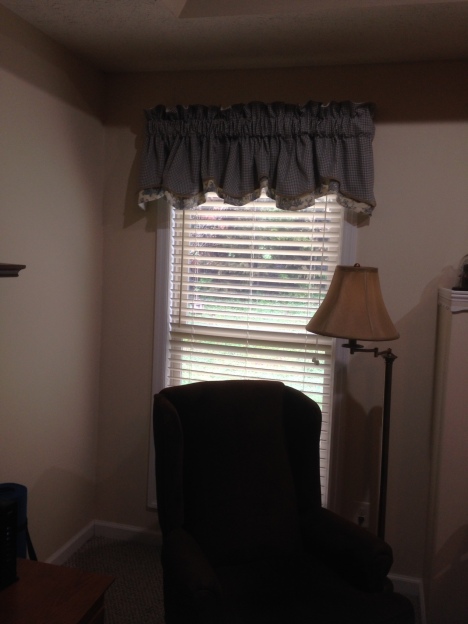Although spring is one of my favorite seasons, I haven’t always decorated for it. Even as I collected some spring decorations over the years, I haven’t always gotten them out. But this year I was inspired by seeing blogging friends’ spring decorating, and I was just so glad for spring to come this year, even though we haven’t really had a harsh winter, that I almost couldn’t help bringing some springiness into the house.
This little table sits just inside the front door, and I was especially pleased with the decorations on top:


The little flower arrangement on the left I got from a thrift store years ago, and the arched box on the right was a gift from Jason and Mittu some years back. It’s meant to hold Willow Tree figurines and has shelves inside, but I don’t have any that small, and don’t really want any more than I have. But I just like the box. Sometimes Timothy will tuck things in there, and sometimes I’ll put something in there for him to find. Those two are on the table year round except fall and Christmastime. The ceramic water pitcher I got at a thrift store years ago, and the little flowery bunny was a Hobby Lobby purchase a while back.

So cute!
The little pedestal is new this year.

I got the idea from Laura’s lovely spring decorations. I couldn’t find white like she had, but Hobby Lobby had these in pink, blue, yellow, and green, and they had all their spring merchandise 40% off last week. They had a package of ready-made nests with these eggs in them as well. I was originally looking for white or blue eggs, but liked these.
For a long time I avoided eggs and bunnies around Easter, but after a while I felt that they are fitting for spring, and spring is a picture in a way of the resurrection.
This is in the dining area and is a favorite. I forget where I got it.
I had wanted to come up with a new wreath or something for the front door – or actually for beside the front door. Our door has an oval glass insert which doesn’t seem conducive to wreaths or other decorations, and a little hanger was already installed in the brick next to the door, so we use that. In past years I’ve used this:
 (That’s an older photo on a different door). I liked it, but somehow it looked funereal to me. Plus roses and hydrangeas aren’t blooming yet, so I wanted something a little more springy. I wrestled with whether I wanted it to look like spring in general or Easter in particular. On some of my shopping excursions last week, I looked around to see what was available. I definitely wanted tulips, but there were almost none in the fake flower departments, and what I did find, I didn’t like. I guess I should shop earlier in the year for fake spring flowers! After walking all around a few different stores, I finally found one lone tulip bunch at Hobby Lobby, a few half-off sprays at Joann’s and a small cheapy arrangement at Wal-Mart that I harvested to put together for this:
(That’s an older photo on a different door). I liked it, but somehow it looked funereal to me. Plus roses and hydrangeas aren’t blooming yet, so I wanted something a little more springy. I wrestled with whether I wanted it to look like spring in general or Easter in particular. On some of my shopping excursions last week, I looked around to see what was available. I definitely wanted tulips, but there were almost none in the fake flower departments, and what I did find, I didn’t like. I guess I should shop earlier in the year for fake spring flowers! After walking all around a few different stores, I finally found one lone tulip bunch at Hobby Lobby, a few half-off sprays at Joann’s and a small cheapy arrangement at Wal-Mart that I harvested to put together for this:
I don’t remember where I got that green pocket holder years ago, but I love it. It’s nice to just toss things in without having to use hot glue or a form to stick the flowers in. I had been considering the idea of a wreath with tulips and a little nest nestled in, and maybe I’ll try that next year, but for now I like this.
I ended up with some leftover flowers after all of that, so I put them in here:
I had an egg on a pick leftover from a flower arrangement years ago and found a package of them at Hobby Lobby, and tried a few of them in the pocket arrangement above, but it just looked too busy. I think if the flowers had been all one color, it would have worked better. I debated about whether to put any in this little arrangement, but finally settled on just the one.
In addition, these two are out year round, but they do look springy!
This is beside my kitchen sink. I don’t remember where I got the little pitcher: I’ve had it for years. But the flowers were just two picks from Home Interiors. I do change the flowers out for fall and Christmas.
The lighting wasn’t ideal for this photo – the sun was streaming in blindingly, but when I closed the blinds and turned on all the lights, it wasn’t quite enough for a clear shot. But anyway, the cloche with the bird nest in it was from Cracker Barrel (I think I may have hinted at it for a gift for Mother’s Day one year. 🙂 ) And the little birds were on sale at Hobby Lobby a couple of years ago. The little plaque is metal and I think came from a Christian bookstore in SC.
I enjoyed working on this last week, and now I feel sufficiently springy inside. 🙂

















































